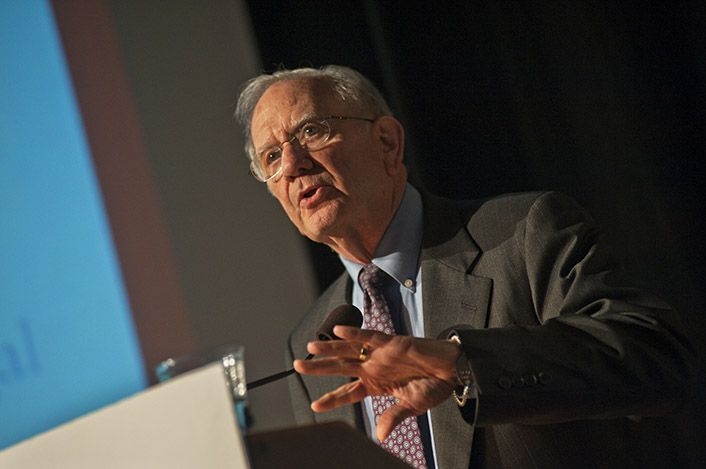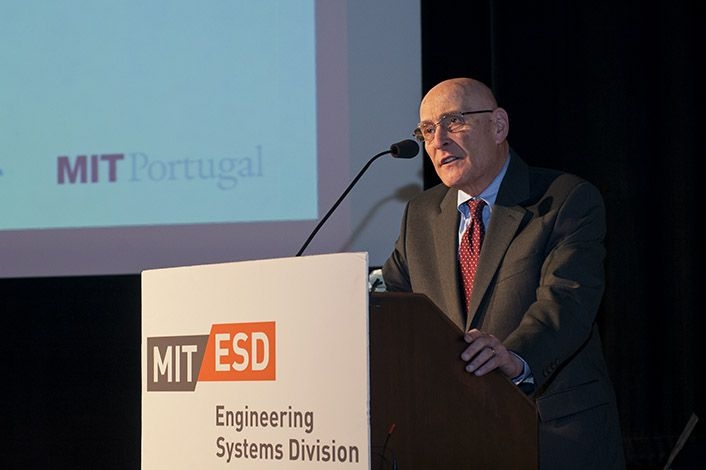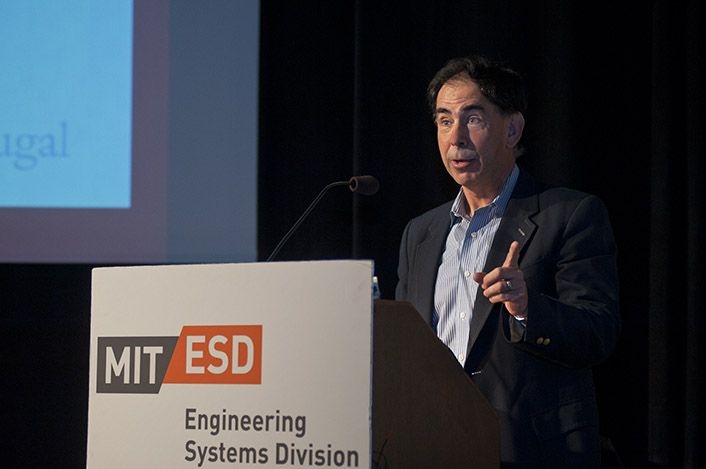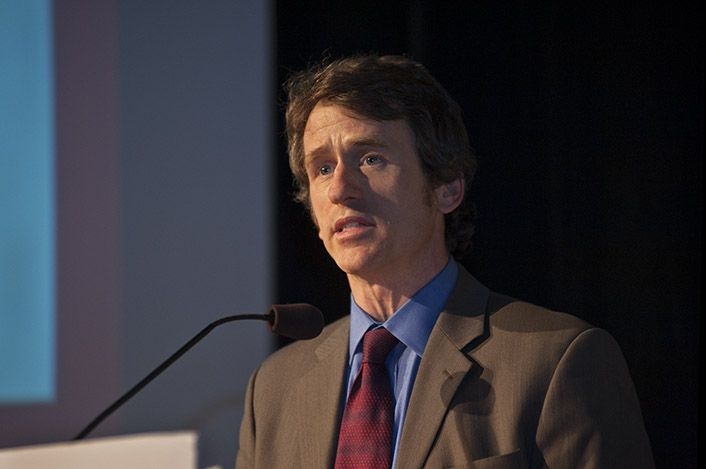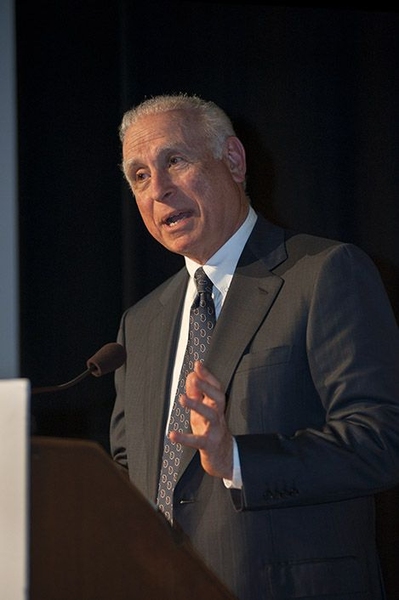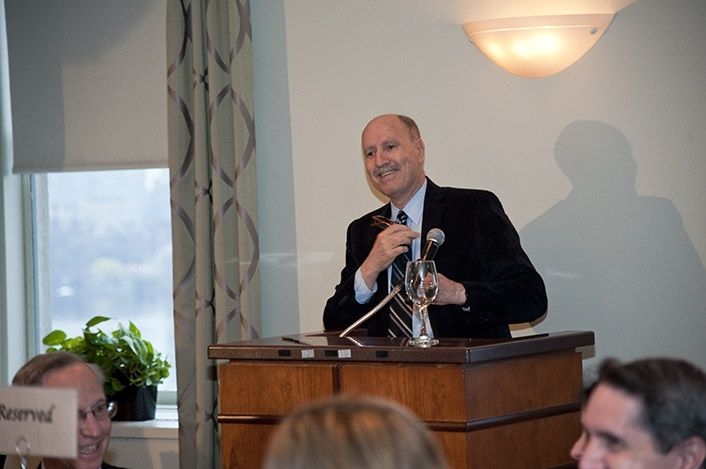The MIT Engineering Systems Division (ESD) presented the April 20 symposium "The Evolution of Engineering Systems: A Rich Past, an Exciting Future," honoring Professor Daniel Roos, founding director of ESD.
Held in Bartos Theater, this event was the Charles L. Miller Symposium and was co-sponsored by the Department of Civil and Environmental Engineering; MIT Center for Transportation and Logistics; MIT Center for Technology, Policy, and Industrial Development; and MIT Portugal. The event can be watched online in ESD's collection on TechTV.
Moderated by J.R. East Professor Joseph Sussman, the symposium featured several speakers who have worked with Roos over the course of his time at MIT (55 years at the Institute, serving on the faculty since 1966) — offering a chronological overview of some substantial projects in areas such as computer systems, urban transportation and international education. Many of these projects — which involved not only significant technical components, but also complex systems encompassing people, processes, and policies — would later prove to be antecedents of the Engineering Systems Division, established in 1998.
Professor Edward Crawley spoke on “The Internationalization of MIT,” particularly in the context of Roos’ efforts in a number of significant international partnerships. Crawley discussed the prospect of what a global university might look like, and explained how Roos’ abilities as an effective facilitator of international relationships have contributed to the Institute.
“I think [MIT’s] future success as an international, global university in large part rests on Dan’s contributions,” Crawley said.
Associate Professor P. Christopher Zegras continued on this theme of international partnerships, highlighting specifically the MIT Portugal Program. He described crafting effective industry-academic collaborations as “trying to find the space of synergy where we can bring the power of scientific research together with the public and private interests to pioneer new ways of solving problems.”
Arthur Gelb (president of Four Sigma Corp. and member of several MIT visiting committees, including ESD’s, of which he is a former chair) charted some of the history of ESD. Gelb described the beginning of the Technology and Policy Program (TPP) in 1975. TPP was followed by a number of other integrative master’s programs, including Leaders for Manufacturing (now Leaders for Global Operations), System Design and Management, and Master of Engineering in Logistics (now the Supply Chain Management Program, but the degree name remains the same). Gelb pointed out that the development of the MIT Engineering Systems Division was motivated not only by a need for a “home” for these programs, but also by “a strong intellectual and practical motivation.”
“MIT needed to be a player in the huge sociotechnical systems that are important to the country — and to our society,” Gelb said. “These [systems] belonged to no one [particular department] at MIT. Clearly, an integrating unit was the arguable right place to focus — with foundations in engineering, management and the social sciences.
“Successfully attacking crucial systems problems requires new understanding,” he said. “The intellectual underpinning of ESD promotes this understanding — it is being put together brick by brick, or, I should say, thesis by thesis, book by book, symposium by symposium. ESD enables a very important way in which MIT can contribute to the world in which we live.”
In offering the final remarks of the symposium, Roos mentioned the forthcoming engineering systems book series from MIT Press, which will include the book Engineering Systems: Meeting Human Needs in a Complex Technological World (which Roos authored with Associate Professor Olivier de Weck and Professor of the Practice Christopher Magee). Roos read from the book's foreword, written by Charles Vest, MIT president emeritus and president of the National Academy of Engineering.
“‘The days of analyzing and designing based only on Newton’s laws, Maxwell’s equations and the principles of chemistry are dwindling,’” Roos read. “‘The grand challenges of the age we are entering — sustainability, health, security and joy of living — cannot be met without engineering, but they certainly cannot be met by applying technology as we generally think of it.’”
Roos also spoke about the Council of Engineering Systems Universities (CESUN), which now includes more than 50 universities and was founded by ESD. He cited the Masdar Institute of Science and Technology and Singapore University of Technology and Design as major new universities that each have a curriculum deeply rooted in engineering systems.
“A lot is happening, both in existing schools and in new universities, and therefore I would suggest that the title of this symposium is quite accurate,” Roos said. “I look to the future of engineering systems with great excitement.”
Held in Bartos Theater, this event was the Charles L. Miller Symposium and was co-sponsored by the Department of Civil and Environmental Engineering; MIT Center for Transportation and Logistics; MIT Center for Technology, Policy, and Industrial Development; and MIT Portugal. The event can be watched online in ESD's collection on TechTV.
Moderated by J.R. East Professor Joseph Sussman, the symposium featured several speakers who have worked with Roos over the course of his time at MIT (55 years at the Institute, serving on the faculty since 1966) — offering a chronological overview of some substantial projects in areas such as computer systems, urban transportation and international education. Many of these projects — which involved not only significant technical components, but also complex systems encompassing people, processes, and policies — would later prove to be antecedents of the Engineering Systems Division, established in 1998.
Professor Edward Crawley spoke on “The Internationalization of MIT,” particularly in the context of Roos’ efforts in a number of significant international partnerships. Crawley discussed the prospect of what a global university might look like, and explained how Roos’ abilities as an effective facilitator of international relationships have contributed to the Institute.
“I think [MIT’s] future success as an international, global university in large part rests on Dan’s contributions,” Crawley said.
Associate Professor P. Christopher Zegras continued on this theme of international partnerships, highlighting specifically the MIT Portugal Program. He described crafting effective industry-academic collaborations as “trying to find the space of synergy where we can bring the power of scientific research together with the public and private interests to pioneer new ways of solving problems.”
Arthur Gelb (president of Four Sigma Corp. and member of several MIT visiting committees, including ESD’s, of which he is a former chair) charted some of the history of ESD. Gelb described the beginning of the Technology and Policy Program (TPP) in 1975. TPP was followed by a number of other integrative master’s programs, including Leaders for Manufacturing (now Leaders for Global Operations), System Design and Management, and Master of Engineering in Logistics (now the Supply Chain Management Program, but the degree name remains the same). Gelb pointed out that the development of the MIT Engineering Systems Division was motivated not only by a need for a “home” for these programs, but also by “a strong intellectual and practical motivation.”
“MIT needed to be a player in the huge sociotechnical systems that are important to the country — and to our society,” Gelb said. “These [systems] belonged to no one [particular department] at MIT. Clearly, an integrating unit was the arguable right place to focus — with foundations in engineering, management and the social sciences.
“Successfully attacking crucial systems problems requires new understanding,” he said. “The intellectual underpinning of ESD promotes this understanding — it is being put together brick by brick, or, I should say, thesis by thesis, book by book, symposium by symposium. ESD enables a very important way in which MIT can contribute to the world in which we live.”
In offering the final remarks of the symposium, Roos mentioned the forthcoming engineering systems book series from MIT Press, which will include the book Engineering Systems: Meeting Human Needs in a Complex Technological World (which Roos authored with Associate Professor Olivier de Weck and Professor of the Practice Christopher Magee). Roos read from the book's foreword, written by Charles Vest, MIT president emeritus and president of the National Academy of Engineering.
“‘The days of analyzing and designing based only on Newton’s laws, Maxwell’s equations and the principles of chemistry are dwindling,’” Roos read. “‘The grand challenges of the age we are entering — sustainability, health, security and joy of living — cannot be met without engineering, but they certainly cannot be met by applying technology as we generally think of it.’”
Roos also spoke about the Council of Engineering Systems Universities (CESUN), which now includes more than 50 universities and was founded by ESD. He cited the Masdar Institute of Science and Technology and Singapore University of Technology and Design as major new universities that each have a curriculum deeply rooted in engineering systems.
“A lot is happening, both in existing schools and in new universities, and therefore I would suggest that the title of this symposium is quite accurate,” Roos said. “I look to the future of engineering systems with great excitement.”
